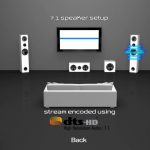Quality sound output can be a game-changer when it comes to watching movies. It’s like being transported right into the world of the film, where every sound surrounds you and brings the whole experience to life. From the softest whispers to the thunderous explosions, you hear it all with absolute precision.
That’s why watching a movie without surround sound feels like missing out on the full experience.
Emerging audio technologies have revolutionized the cinematic experience like never before. Two big players in the surround sound game are DTS:X and Dolby Atmos, and they both claim to offer the best immersive sound experience possible.
Now, you may have heard about them before, but you might still be wondering: What exactly are DTS:X and Dolby Atmos?
Well, buckle up, folks, because we’re about to take you on a tech ride to unravel the mysteries behind these two audio standards. We’ll dive into their approaches and how they function, and of course, compare their features to see which one truly stands out.
So, are you ready?
The powerful DTS:X?
DTS:X is one popular object-based surround sound standard. It encodes sounds as objects instead of channels. It surfaced in 2015 as a home cinema device before making its way into cinemas. Like its rival, DTS:X is super compatible with 5.1 as well as 7.1 speaker setups. (Note that, here, 7.1 indicates 7 speakers and 1 subwoofer setup, while the former represents 5 speakers and 1 subwoofer setup)
Like its rival, it completely envelops your senses with quality sound output, providing an absolutely immersive experience. However, it operates differently than the Dolby Atmos system.
DTS:X places sound as objects, allowing them to be positioned in specific locations around the room based on the action in the film.
You actually feel like you are being transported into the world of the movie and sensing even those hushed dialogues with absolute clarity and hearing the birds flying past your sides or overhead.
The Magic of Dolby Atmos
Unlike the DTS:X, the Dolby Atmos has a long journey. It made its first appearance in cinemas in 2012, with a promising immersive surround sound experience. But its approach toward an enveloping sound output is pretty different than that of DTS:X.
Like its counterpart, Dolby Atmos also operates on object-based surround sound to provide absolute immersion. However, it is specifically particular about height effects.
That’s exactly why you must install ceiling speakers with a Dolby Atmos setup, or else you might miss out on the full fun.
While ceiling speakers may not be affordable for everyone, fortunately, the market is flooded with Dolby Atmos-certified speakers and soundbars. These devices offer more or less the same experience with built-in upward-firing drivers. These technologies help the sound bounce off the ceiling and produce the height effects to provide a full Dolby Atmos effect.
Audio Showdown: DTS:X vs. Dolby Atmos
Decoding the Battle of Immersive Sound:
There has been a long-standing debate about which is better between the two sound titans: DTS:X and the mighty Dolby Atmos. Well, to begin with, we must remember that both these sound brands are ranked as the best among all cinematic standards.
Additionally, both the standards deliver a 3D sound and an absolutely immersive movie experience like nothing else.
However, since the manufacturers are different, both DTS:X and Dolby Atmos have certain competitive edges over one another in terms of functioning or other related drivers.
So let’s have a closer insight into the features of these two popular sound titans and reach some conclusion.
Number of Speakers:
It’s well-known that a surround sound system requires multiple speakers to envelop your room and provide an immersive sound experience. The same goes for both DTS:X and Dolby Atmos.
But hold on! This is exactly where you find a disparity between the approach of these two sound systems. A DTS:X system takes the lead here, with only six speakers required for a 5.1 surround sound. This, my friend, is mainly because the DTS:X doesn’t require additional audio channels for the height feature, though you may add them if you wish so.
On the contrary, the Dolby Atmos requires quite a handful of speakers to work fine. It is as few as 8 audio channels for the 5.1.2 surround sound and as high as 12 speakers for the 7.1.4 surround sound.
That’s one clear difference between the working of both these sound standards. Here DTS:X might get preferred due to its low requirements for additional audio channels.
However, the number of speakers in the Dolby Atmos setup is higher due to its focus on height effects for producing a 3D sound effect. These height speakers reflect the sound off the ceiling and naturally create a more diffuse experience. The resulting sound thoroughly envelops the audience providing an immersive experience.
Besides this, a Dolby Atmos setup has the capacity to expand to 64 speakers in one surround sound system, whereas the DTS:X only permits a total of 32 speaker feeds. If we look closely at this feature, we can clearly state that the Dolby Atmos offers a more expanded range of speaker feeds for a home theater than that of DTS:X. The number that DTS:X offers is far less than what makes a home theater worthwhile.
However, let’s give credit where it is due. In fairness to its limited speaker connection, it’s worth mentioning that DTS:X takes the cake when it comes to supporting even more extensive sound systems, up to an 11.2 channel system.
Compatibility with Sound Systems:
Perhaps, the most charming factor of DTS:X is its humbleness in terms of compatibility. You absolutely don’t need any certification to implement DTS:X in a sound system. It incorporates an open-source Multi-Dimensional Audio platform (MDA) that doesn’t demand any special permission or licensing to connect to a sound system.
This advanced sound system is universally compatible.
Whereas the Dolby Atmos setup can only be implemented with Dolby-certified devices. It is not compatible with all.
Which one has a higher content rate?
Though DTS:X and Dolby Atmos both lead the industry with unparalleled sound quality, you are more likely to come across Dolby Atmos content compared to its rivals. The world’s top streaming services, i.e., Netflix, Disney, Pixar, and Amazon Prime Video, operate on Dolby Atmos technology, so as the latest game providers and some popular TV broadcast channels. That clearly means Dolby Atmos enjoys more popularity than DTS:X.
You won’t find DTS:X a lot despite the fact that around 90 percent of the Home theater market supports it. DTS:X is mostly confined to Blu-ray players, but it’s worth noting that both the latest and older audio devices can support it. All It requires is a simple firmware update.
The reason behind this is not the performance gap but the popularity gap. Dolby Atmos, being an old player, has gained more popularity and has managed to establish strong partnerships and collaborations with major content creators. Consequently, it won Dolby better brand recognition than its rival.
Last but not least, Dolby Atmos has invested a substantial amount in marketing and promotions, which is likely to give the brand a competitive edge over all others.
However, it is important to note that this popularity can be restricted to geographical locations. While Dolby Atmos may currently hold a stronger position in the market, DTS:X continues to evolve and gain traction in the audio industry with its unique features.
Compatibility with Game Engines:
Here’s the best part: With DTS:X, you can have an incredible gaming experience without breaking the bank. Unlike some other technologies, DTS:X offers a free license to all devices without any extra certification requirements. That means you don’t need to invest in additional hardware.
All you have to do is install the “DTS Sound Unbound” app, and voila! You’ll unlock the power of DTS:X and its other amazing technologies. Whether you’re playing video games or watching movies, this app enhances the performance of your audio setup, making it feel like you’ve upgraded to a much more expensive system.
Best of all, it won’t cost you a dime.
On the contrary, Dolby Atmos demands special certified devices to support it, e.g., headphones and speakers. Therefore, you can’t enjoy a Dolby Atmos ride unless you run it on a compatible and certified device.
Sound output:
Comparing the sound quality of these two standards is not easy. There’s a lot to consider.
But when it comes to bitrates, DTS:X takes the lead. It supports higher bit rates compared to Dolby Atmos.
Now, let’s talk a bit about what bit rate means. It’s all about the speed at which the audio data is processed and compressed by a system. The higher the bit rate, the better the sound quality! That’s a general idea.
But here’s where it gets interesting. Dolby claims to have superior codecs that can produce amazing sound even at lower bit rates. They argue that it’s not all about having a higher bit rate. Dolby experts believe in maximizing sound quality while keeping the bit rate low.
So, there has been quite a long-standing debate about whether it’s better to have DTS:X with its higher bit rate or if Dolby Atmos, being the popular brand that it is, actually works better with lower bit rates. Some argue that Dolby Atmos’ lower bit rate actually results in a higher-quality sound output, but the arguments don’t end here.
The debate is ongoing, and opinions may vary depending on whom you ask. Ultimately, it comes down to personal preference and what sounds best to your ears.
There’s been a long debate on whether it is better to have a DTS:X with a higher bit rate or the Dolby being a popular brand, works better with low bit rates. Many argue that the low bit rate of Dolby Atmos results in producing higher-quality sound output.
Another lovely feature of DTS:X is that it gives you the power to tweak and fine-tune individual sound objects as you wish. Just imagine being able to tweak and crank up those suspenseful dialogues in a movie, making the hushed conversations crystal clear, playing around with background voices, etc. That’s precisely something you crave while watching an action-packed movie, and DTS:X makes it possible for you.
DTS:X allows you to have master control over the sound output making your movie-watching experience worthwhile.
Who wins?
Here comes the final phase of this epic showdown – who wins?
To be honest, since both technologies offer similar results, it’s hard to declare a definitive winner or loser. Both offer immersive sound experiences though the working differs. The shortcoming of one player seems to be canceled out by the merits it offers.
So, to sum up, both are great fighters and are continuously evolving to pull off the best possible immersive sound experience. Best of all, a multitude of speakers and sound setups support both Dolby Atmos and DTS:X technology.
Ultimately, choosing one over another comes down to the availability of the technology, its compatibility as well as personal preferences.

I’m Shaun Conroy, an audiophile & founder of HiFi Audios. Holding a Bachelor’s in Sound Engineering, I bring deep expertise in audio devices and offer insights & recommendations to fellow enthusiasts.





